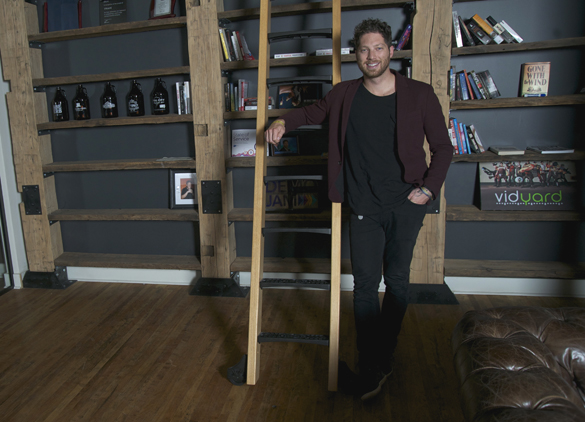 |
|||||
|
|||||
| Vidyard re-invents itself for growth | |||||
| By Paul Knowles | |||||
| Michael Litt, CEO of Vidyard, understands that technology will continue to be “the thing that differentiates us”. And by “us,” he means the generations. “This next wave of leaders doesn’t know what work is without the internet. With this generation, knowing exactly what work was like without the internet,” there’s a mental divide, “compounded by the change in technology which means that this demographic interacts differently, has different expectations of work.” “When you start a company, it’s all you do is to focus on this vision, this dream, and go after it. And then at some point you get mired down with the operation of the business. Once you can find the unique scalability in areas, you can look back up again.” These are deep thoughts. Litt wants to let people know that, “there are things out there, that could be a problem, if we don’t get ahead of it.” He wants to drive some awareness around some of these challenges, “like sexism in AI, like globalization and automation, what that means for jobs and the security of this ecosystem.” He’s extremely grateful to the Waterloo community for giving him the opportunity to do the things he’s been able to do. That includes building a successful company with a remarkable track record, one that is expanding at a rate where he hires new people every other day. His SaaS business model attracts large investments. Software for service can deliver big margins and scalability: “it’s pretty cool”. A graduate from University of Waterloo Engineering, and a native of Kitchener-Waterloo, Litt was first interviewed by Exchange in 2011, as he was just getting involved in the Y Combinator, a Silicon Valley incubator. Graduating from the YC in 2012, he and business partner Devon Galloway spent time learning the Silicon Valley way. “I see coming out of YC as being the real beginning of this company,” says Litt. “Before that, we were kidding around, selling video production services”. Currently Litt says the two partners are winding that video production business down… “We wanted to become a technology business, we wanted to sell a software solution, with a targeted 90% gross margin, in an area where few businesses have found success.” Video communication has been a developing means of generating new B2B business via social media platforms. A good video can be seen by many people, although “it’s very expensive, from a server cost perspective”. Given the domination in the market, says Litt, “It’s very difficult to build solutions that will be used productively when you’re competing against status quo venders like Youtube and Vimeo,” when they have “hundreds and thousands of engineers working on them”. What separates Vidyard from “them”, the interesting thing about their “tech stack”, is that they do more than host video, they’re dashboard friendly, and provide the customer with insights and reports on the interactivity of their presentations. “We can personalize content, the list goes on. Customers expect the same type of deliverability, as youtube provides.” So that’s the aim.
“Back when we chatted, we probably would have had 500 video feeds a week, now we serve north of 50 million video feeds a day.” "In 2011, there were 150 companies that were called “marketing technology ... today, there are 5500 companies in that landscape" Litt is a passionate leader. “Sales is the backbone of any organization. There has to be a close concert between product and sales; it’s never more true that in my industry,” he says. They operate within the marketing technology business industry. Looking back, when they launched, in 2011, there were 150 companies that were called “marketing technology” vendors. “These are companies that we selected [to watch] because they had more than $5 million in annual product recurring revenue. We weren’t on that list because we weren’t at that stage. “Today, there are 5500 companies in that landscape, and budgets have not increased by the order of the number of companies in the space, so it’s highly competitive. We just don’t compete against other video platforms, we compete for budget against everything that is helping that business grow.”
He says, “’I’m going to become a company that finds that massive juicy market,’ is one of the biggest challenges that I think everyone sort of faces, but when you’re in the early stages of just building technology, you’re pretty naive, and if you read the crystal ball and had to look to the future, I think a lot of founders would decide not to invest, because so much time and money goes into that effort. It’s a battlefield. You have to grow to love that side of the business.” What keeps this young entrepreneur, strategically relevant? Litt constantly keeps asking himself, “Where is that next company that is a Mike and Devon? Or what two founders are sitting in their garage, tracking our progress?” Litt makes the point that it’s an ever-changing world, and that it’s not always best to be first with new technology. “First to market means people are going to come and copycat you. You have to retain that sense of culture, and innovation that you once had. As a startup founder, you need that naivety of looking up, to continue to innovate, but you also have to be aware of what is happening around you.” VidYard’s current state is that they are still young and innovative, and they currently have a go-to-market leadership team that Litt describes as “world class in the business.” He says that this “that allows me to get back to, in large part, my original position of looking up”.
As for future entrepreneurs, “when you start a company, it’s all you do is to focus on this vision, this dream, and go after it. And then at some point you get mired down with the operation of the business. Once you can find the unique scalability in areas, you can look back up again. And it almost happens in ‘s’ curves. When Devon and Mike started this company, “we did it on the basis that, if we could do these productions projects that were worth, say, $20,000 dollars, and the two of us could do 10 to 15 of these a year, we’d live happily ever after. That was our vision and we got there.” The eureka moment came when it occurred to them that “if we could get 1000 customers, paying us $500 Litt stresses the need for a long term vision. “That’s what keeps you innovating. But you [also] have to have short term goals. Because if you’re only chasing your long term goal and fixed on that perspective, there will be moments in your business where you feel like nothing is going right. Because even at this stage the highs are highs and the lows are really low. But the most important thing, when the lows are low, is to come into the office, and figure out how to fix that problem. You will only feel better when you’re in that motion and in that moment … you learn to love it.” |
|||||
 Not a Subscriber? Receive more business profiles on meaningful people to you. Sent directly to your in box. Our 35th Anniversary Gift To You! Save $14.88 with our first 35th Anniversary subscription digital launch offer. No Cash Value. Cancel anytime. |
|||||
| contact us
Publisher is Exchange Business Communication Inc. |






